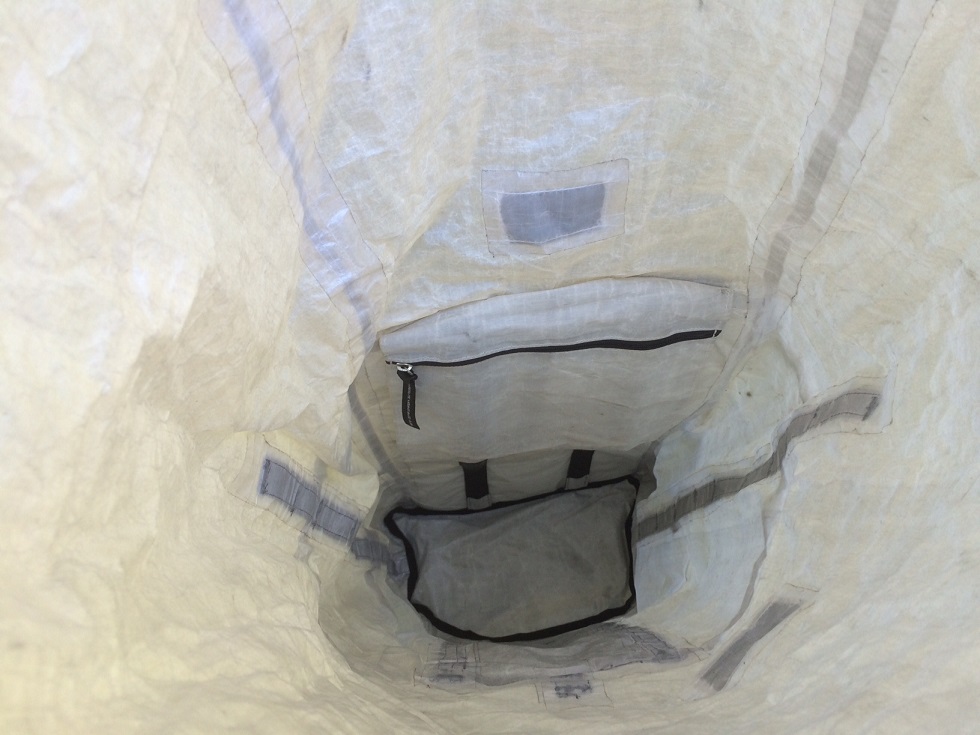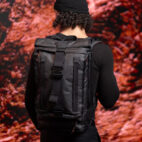
Backpacks

Road Tests :: Hyperlite Mountain Gear 2400 Ice Pack
Unsure of whether I was entering a dream or waking up from one, I found myself in a helicopter buzzing through a New Zealand canyon marveling at the contrast of the lush valley below and the glacier-carved mountains surrounding us. I was in a party of four shortcutting a two-day hike with a thirty-minute adrenaline rush up to the glacier. After being thwarted by the weather in an attempt to climb Malte Brun a few days earlier we were maximizing our chances at summiting Mount Aspiring, New Zealand’s sixth highest peak, by getting there as quickly as possible.


When planning a trip like this I enjoy geeking out on gear. After laying out all of my climbing, camping, and winter gear I realized there would be two nice-to-haves: an ultralight summit bag capable of carrying ice axes and crampons, and a set of hiking poles. Looking back, I’m glad these were two items I’d sought out; both proved extremely beneficial.
It didn’t take long for my search of “ultralight mountaineering bags” in Google to bring up Hyperlite Mountain Gear (HMG), go figure. It’s a brand that specializes in high-tech materials and stripped-down designs to give their customers exactly what they need and nothing else; perfect. I chose the 2400 Ice Pack that uses state-of-the-art Dyneema® Composite Fabrics (formerly Cuben Fiber) - a fabric known for its strength, weatherproofness, and weight (or lack thereof). In addition, HMG designed this pack to carry ice tools and crampons which are notoriously sharp things to carry. I eagerly awaited its arrival.
The pole search wasn’t difficult either. I wanted a set that was light and folded small. In general I’m a big fan of Black Diamond so I grabbed a pair of their newly released Alpine FLZ Trekking Poles that compromises a little extra weight for adjustability.
"I chose the 2400 Ice Pack that uses state-of-the-art Dyneema® Composite Fabrics (formerly Cuben Fiber)- a fabric known for its strength, weatherproofness, and weight (or lack thereof). In addition, HMG designed this pack to carry ice tools and crampons which are notoriously sharp things to carry"
The helicopter pilot let us down softly and took off to fight bad guys, rescue someone hanging from a cliff (possibly Stallone), or something equally as bad-ass I’m sure. We had to hike to the hut where we would spend the night before our summit attempt the following morning. The weather was gracious, the rope team quick, and the views spectacular.
With a 2 am wake-up time we tried to rest but mostly laid awake listening to each other's struggle to sleep. Alarms ring, breakfast is smashed, boots are laced, and packs are shouldered. Before the fourth member of the group exited the hut it started to drizzle. After almost a week of being bullied by the weather we were determined to push through it in the hopes of clearer skies ahead. An hour in and it’s raining, no longer a friendly drizzle. Everything is wet, either from the outside in or from the sweaty inside out. One of our crew decides to turn around – always the reasonable one – and the rest of us push ahead. Two hours in and there’s no sign of calmer weather. We decide to hide out in a cave for some much-needed laughter where I was delighted to find the contents of the Ice Pack as dry as when we started, especially the extra pair of gloves I’d stashed inside. The space-age material not only kept the contents dry but my bag was by far the lightest in our group.


After an hour of hiding in the cave like Gollum we dejectedly decided to bail on the attempt. After getting back to the hut we had a decision to make. Stay another day and try again or begin the hike out. This time cautious minds prevailed and we decided to hike out before the next weather pattern rolled through the following evening. The Ice Pack got stashed back inside my larger expedition pack and the Black Diamond poles were clicked into service for the glacier traverse. Their design is similar to a tent pole and deploying them and stashing them was quick and painless. Having received some bad beta on the best way to hike out we headed up the glacier expecting a 6 to 8-hour hike to the next hut. Instead we met a disheveled glacier ravaged by a warm summer; cracked and busted, the crossing was slow and treacherous. Gut-wrenching scenes like this were not uncommon…

The Black Diamond poles were a godsend for me given that I was only traveling with one mountain axe. Although very unorthodox, by having the axe in one hand and a hiking pole in the other I was able to cross the most dangerous terrain I’ve ever been on without falling a step behind.
Ten hours later and still half a day away from the hut we decided to sleep on the glacier itself, no tents, no sleeping pads, just packs, a rope, and sleeping bags to keep us warm. The rope and packs were laid out as our cozy mattress for four. While the Ice Pack and other packs weren’t ever designed to be sleeping pads it’s nice to know they’ll help keep you alive in a pinch.
Four exhausted and strung out humans awoke that morning, silently packed, and headed for the comfort of an alpine hut. We were shattered to find the way down to the hut to be an exposed slope of unstable ice and rock that was much too risky to descend. Facing an impassable slope ahead, an unthinkable return across the glacier we’d just traversed, and an unfriendly weather system coming in that night we thought it best to dust off the satellite phone and call our bad-ass helicopter pilot to come and get us.
The lessons learned were many and the relief of being safe in a pub that night is not one I’ll soon forget. The trip was a reminder that detailed planning is crucial, mountain weather should always be respected, and that having the right gear – and a fearless Kiwi helicopter pilot – can literally save your life.
Below are my more detailed thoughts on the Ice Pack. The poles are recommended for sure, though I think you’ll find most of the high-end poles out there to be good so you should grab a pair that suits your needs.

Specifications
- Name: 2400 Ice Pack
- Brand: Hyperlite Mountain Gear
- Format: Roll-top backpack
- Measurement: Top Circumference: 37.5” (95.3cm); Bottom Circumference: 33.5” (85.1cm); Height (fully unrolled): 30” (72.6cm); Back Width: 10.5” (26.7cm)
- Capacity: 2400 cu. in. (40L)
- Weight: 2.11 lbs | 33.8 oz | 958g
- Zippers:
- Material: Body: 50D Dyneema®/Poly hybrid; Bottom: Double reinforced 150D Dyneema®/Poly hybrid
- PriceUS$ 285
Who It Suits
The summit bagger who wants essential features, ultralight materials, and nothing else. For anyone who enjoys technical mountaineering and is looking to shave some weight the bags at HMG are a good place to look.
Who It Doesn't
The outdoor enthusiast looking for an all-rounder. With only top access, no extra pockets, and a short list of specialist features the general outdoorsman should look for something more versatile.
"While the Ice Pack and other packs weren’t ever designed to be sleeping pads it’s nice to know they’ll help keep you alive in a pinch."


Design
Construction
They’ve reinforced the bottom with an extra layer of 150 denier Dyneema after receiving feedback on the first version of the Ice Pack, which should help give it a longer life.
Materials
This bag is exceptionally lightweight. Guaranteed you’ll be impressed the first time you lift it. The material feels a bit crinkly but is a constant reminder that your bag is from the future.
"The space-age material not only kept the contents dry but my bag was by far the lightest in our group."

Features
There are two sturdily stitched daisy chains on the back of the pack to clip gear. There is also a gear loop on either side of the flat and comfortable hip belt, giving you an excellent place to store gear instead of on your harness.

The crampon and ice tool carry setup is simple and effective.


Performance
Comfort
The shoulder straps are simple with enough padding and width to be comfortable and with a few more gear loops for your gear clipping needs.


Space and Access
The pack is a roll-top design with a volume of 2400 cu. in (40 liters). There's a zipped interior pocket for storing smaller items.

Weatherability
The fabric kept the bag’s contents dry even in a steady rain.
Others To Consider
There are a number of other brands in the ultralight space that should be on your radar if you're after a lightweight mountaineering bag. Check out the likes of Granite Gear (we reviewed their Virga 26), ZPacks and Gossamer Gear.

The Good
- Exceptionally lightweight
- Daisy chains and gear loops to attach extra gear
- Weatherproof construction
The Not So Good
- Dyneema Composite Fabric is a little pricey, hence a pack made of it will follow suit. This pack is not the cheapest out there.


Verdict
The Ice Pack is an excellent technical bag and deserves to be on the shortlist for best bags in its category. Every aspect of it reminds you this is not your average day bag; from the ultralight Dyneema fabric to its mostly white styling it belongs at altitude pushing for the summit. Though our summit attempt was drowned by the New Zealand weather it still performed well and I hope to snap a picture of it on a sunnier mountaintop soon.





 Carry Awards
Carry Awards Insights
Insights Liking
Liking Projects
Projects Interviews
Interviews









